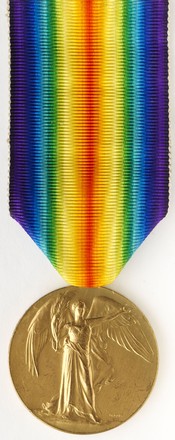Victory medal, 1914–1918 awarded to Hon Capt GW Lambert, AIF, c. 1920
R 344/4
Bronze with silk ribbon
When Lambert first arrived in
Egypt in January 1918 he wrote ‘I am ridiculously happy. Already I have done
three pieces of work and everywhere I look there are glorious pictures, magnificent
men and real top-hole Australian horses.’
In G.W. Lambert, A.R.A.
(Thirty years of an artist’s life) by Amy Lambert, 1938
Civilians who worked with the armed services
By Australian War Memorial
The Victory Medal was awarded to all those who served in the armed
forces during the First World War. Civilians who worked with the armed services
as well as those who served in military hospitals also received this medal.
The
medal has a rainbow coloured ribbon and shows the figure of victory with her
left arm extended and her right arm holding a palm branch.
The Victory Medal was authorised in 1919
By Australian Government, Department of Defence
The
Victory Medal was authorised in 1919 to commemorate the victory of the Allied
Forces over the Central Powers. Each of the Allied nations issued a ‘Victory
Medal’ to their own nationals. Each nation used the standard ribbon but used
different designs on the medal to reflect national identity and custom. A
number had the figure of Victory on the obverse. Australians were awarded the
medal issued by Great Britain.
The
Victory Medal was awarded to prescribed classes of persons who entered a
theatre of war on duty between 5 August 1914 and 11 November 1918.



 Back to list
Back to list